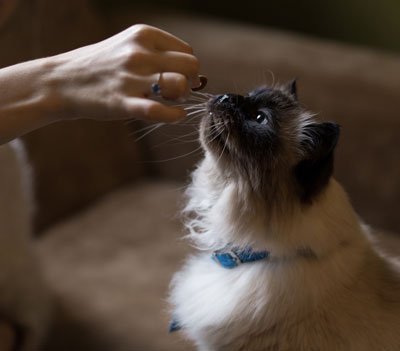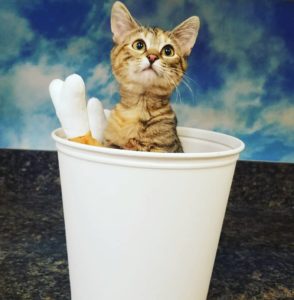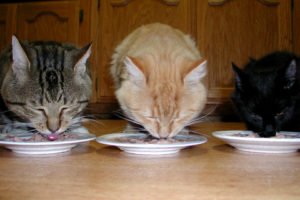Feeding Cats – Addressing Behavioral Needs

What we feed our cats is very important, but so is how we feed them. How we feed our cats can affect them physically and emotionally.
All cats are carnivores (meat eaters), so they have a strong hunting instinct. They also prefer to eat alone and multiple small meals daily.
Satisfying the need to hunt and eat small meals alone, will make your cat happier and healthier, and avoid over or underfeeding. This may include using puzzle or automatic feeders, and in multiple cat homes arranging food and water to reduce stress between your cats.
CURRENT FEEDING METHODS
Your cat’s environment, including feeding routine, positively or negatively impacts quality of life. Most pet cats rely on humans for food. Cats are frequently fed in one location with relatively large volumes of food once or twice a day. Many cats always have food available.
In homes with multiple cats, some cats may not get along with others. Even though cats will eat together, group feeding can cause gorging, feeding aggression, and even weight issues. Cats are very good at hiding signs of distress, so even though they may not show you clear signs of anxiety or fighting when eating together, underlying anxiety and stress affects their well-being.
Obesity-related problems:
- Feeding one or two large meals does not meet a cat’s need to eat many small meals. This approach to feeding can lead to inactivity, stress, overeating, and obesity.
- If a cat is bored, eating can become an activity, leading to obesity. Overweight cats have more difficulty performing physical activities such as jumping, climbing, hunting and playing. Obesity can also lead to health problems such as diabetes, arthritis, high blood pressure, and heart and respiratory disease.
Stress related problems:
- Stress can lead to medical issues such as cystitis (bladder inflammation), and can contribute to litter box issues.
- A cat may eat too quickly in order to return to their safe space if they are trying to avoid a stressful encounter with another pet or a household member such as an active toddler.
- If a cat is not able to access food regularly, because of the possibility of a stressful encounter with another pet or child, they may eat too little or overeat.
DEVELOP FEEDING SOLUTIONS FOR YOUR CAT
 When creating feeding plans, mimic the cat’s natural feeding behavior. This reduces begging for food, feline frustration, and inter-cat conflict.
When creating feeding plans, mimic the cat’s natural feeding behavior. This reduces begging for food, feline frustration, and inter-cat conflict.
Puzzle Feeders and Hunting
Puzzle feeders (food puzzles) are objects that hold food and must be handled by the cat to get the food out. Using puzzle feeders and even hiding kibbles around the home increases activity, and provides mental and physical stimulation. There are many types of puzzle feeders you can buy, or easily make at home. Puzzle feeders vary in their complexity, can be motionless or rolling, and can be designed for dry or wet foods. Always start with simple puzzle feeders first because your cat needs to learn how to use them.
As your cat gets comfortable with using them, you can slowly make them more difficult. For more information on puzzle feeders, visit www.catfriendly.com/howtofeedcats.
Encourage your cat to hunt and forage for food by placing kibbles and treats in different locations. Be patient and slowly incorporate new feeding methods.
Frequent Meals and Appropriate Nutrition
Divide your cat’s daily food allowance into multiple small meals fed throughout the 24-hour period. Use puzzle feeders when possible. Automatic feeders can also be helpful although they do not typically provide for hunting or foraging.
Make sure your cat is actually eating an appropriate amount, especially if you have more than one cat. Contact your veterinarian to discuss how many calories your cat should eat. Food needs to be located where your cat can reach it.
If your cat is over or under-eating, or if you are having trouble feeding one or multiple cats in your home, please contact your veterinarian for advice. Weight and body condition need to be monitored by you and your veterinarian regularly, especially in cats that are older, have chronic illnesses or conditions, or special needs.
SEPARATE RESOURCES FOR HOMES WITH MULTIPLE CATS
 Remember, just because cats will eat together, does not mean they should. Forcing a cat to eat in proximity to another cat that they otherwise try to avoid often creates anxiety, stress, and health problems.
Remember, just because cats will eat together, does not mean they should. Forcing a cat to eat in proximity to another cat that they otherwise try to avoid often creates anxiety, stress, and health problems.
In multiple pet households, offer separate feeding stations with distance and visual separation between cats, as well as utilize elevated space, to reduce stress and associated health issues.
First, determine the household group dynamics to best locate food and water stations (as well as litter boxes). Ask yourself these questions: Which cats spend time together? Which cats avoid each other? Where does each cat spend their time? Place food, water, and litter boxes accordingly.
Next:
- Watch for signs of anxiety or tension during feeding time. Cats need to feel safe when eating. When cats are anxious or tense, you may see vigilant behavior including constant looking around, approaching the food with caution, ear flattening or positioned sideways in ‘airplane’ position, or a hunched or crouched posture.
- Make sure each cat has their own food and water bowl. These should be in a separate location for each cat. Some cats that are able to jump may prefer to eat on counters or other elevated spaces. It may be helpful to put food and water bowls where each cat spends most of their time, but not close to litter boxes.
- Make sure that one cat does not ‘guard’ or ‘commandeer’ the food.
- Place food with a visual separation so cats cannot see one another.
- Meals can be offered through programmable feeding bowls; some utilize individual microchips, only allowing one cat to access the bowl.
Cats need to hunt and search for food, and to eat multiple small meals each day in privacy. You can meet these needs with puzzle feeders and by portioning food throughout the day, which reduces inactivity, anxiety, and obesity. Your veterinarian can help you develop a feeding strategy to meet your cat(s)’ individual needs, and an overall plan that works in your household.
We are here to help you with your cat’s healthcare. Please do not hesitate to contact any of our locations if you have any questions or concerns.
Courtesy of catvets.com and AAFP- Behavior (15)
- Caring for your pet (292)
- cat (16)
- Community Events (20)
- dog (17)
- From Our Clients (15)
- Happy Tails (12)
- News (454)
- Press (53)
- Products (2)
- Questions (4)
- Recalls (1)
- Special Offers (6)
- Tips & Advice (231)
- Uncategorized (21)
- Veterinary Services (49)
